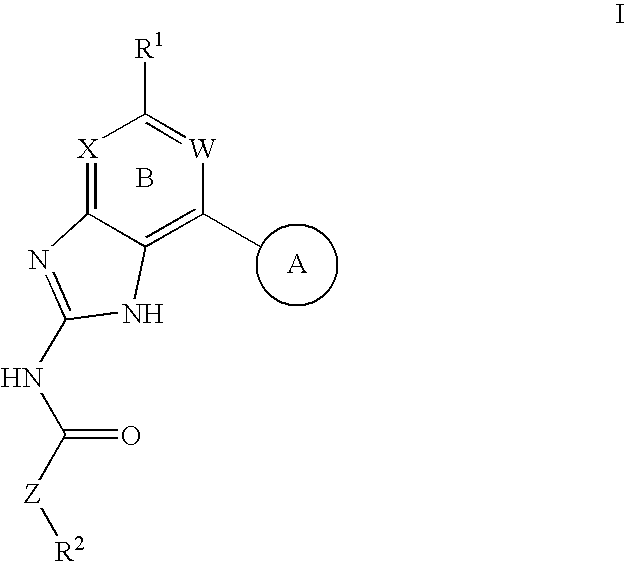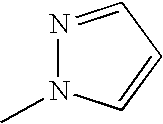Gyrase inhibitors and uses thereof
a gyrase inhibitor and inhibitor technology, applied in the field of medicinal chemistry, can solve the problems of bacterial infections that are difficult to treat with antibiotics or even untreatable, and are considered to be a serious worldwide health problem, and the problem of bacterial infections is becoming particularly serious
- Summary
- Abstract
- Description
- Claims
- Application Information
AI Technical Summary
Benefits of technology
Problems solved by technology
Method used
Image
Examples
example 1
[0160]5-Bromo-1,3-difluoro-2-nitro-benzene: To a suspension of sodium perborate tetrahydrate (1.04 g, 5 mmol) in acetic acid (20 mL), stirred at 55° C., was added a solution of 4-bromo-2,6-difluoroaniline in acetic acid (10 mL) over 1 hour in a dropwise fashion. After stirring at 55° C. for an additional 3 hours, the solution was allowed to cool to room temperature and filtered. The filtrate was poured into ice, and extracted twice with ethyl acetate. The combined organic extracts were washed successively with 5×100-mL portions of water, brine, dried (MgSO4), and concentrated in vacuo. The resulting residue was purified by column chromatography over silica gel eluted with ethyl acetate:hexanes (1:20) to afford 780 mg of the title compound as a tan solid. 1H NMR (CDCl3) δ 7.32 (dt, 2H).
example 2
[0161]1-(5-Bromo-3-fluoro-2-nitro-phenyl)-1H-pyrazole: To a suspension of sodium hydride (44 mg, 1.1 mmol, 60% oil dispersion) in THF (4 mL), stirred at 0° C., was added a solution of pyrazole (72 mg, 1.05 mmol) in THF (1 mL). The resulting mixture was stirred at 0° C. for 5 minutes and a solution of 5-bromo-1,3-difluoro-2-nitro-benzene (238 mg, 1 mmol) in THF (1 mL) was added. The mixture was stirred at room temperature for 1 hour, quenched by addition of water (1 mL), then partitioned between water (20 mL) and ethyl acetate (50 mL). The organic layer was washed with brine, dried (MgSO4), and concentrated in vacuo. The residue was purified by column chromatography over silica gel eluted with ethyl acetate:hexanes (1:6), to afford 240 mg (86%) of the title compound. 1H NMR (CDCl3) δ 6.55 (t, 1H), 7.45 (d, 1H), 7.60 (s, 1H), 7.80 (m, 2H). MS M+1 287, M+1+2 289.
example 3
[0162]5-Bromo-2-nitro-3-pyrazol-1-yl-phenylamine: To a solution of 1-(5-bromo-3-fluoro-2-nitro-phenyl)-1H-pyrazole (240 mg, 0.84 mmol) in ethanol (3 mL) was added ammonia (3 mL, 2N in methanol. The resulting mixture was heated in a sealed tube at 80° C. for 16 hours then concentrated in vacuo. The residue was purified by column chromatography over silica gel eluted with ethyl acetate:hexanes (1:3) to afford 205 mg (86%) of the title compound as a yellow solid. 1H NMR (CDCl3) δ 5.20 (br s, 2H), 6.50 (t, 1H), 6.9 (d, 1H), 7.1 (d, 1H), 7.7 (d, 1H), 7.8 (d, 1H). MS M+1 283, M+1+2 285.
PUM
 Login to View More
Login to View More Abstract
Description
Claims
Application Information
 Login to View More
Login to View More - R&D
- Intellectual Property
- Life Sciences
- Materials
- Tech Scout
- Unparalleled Data Quality
- Higher Quality Content
- 60% Fewer Hallucinations
Browse by: Latest US Patents, China's latest patents, Technical Efficacy Thesaurus, Application Domain, Technology Topic, Popular Technical Reports.
© 2025 PatSnap. All rights reserved.Legal|Privacy policy|Modern Slavery Act Transparency Statement|Sitemap|About US| Contact US: help@patsnap.com



